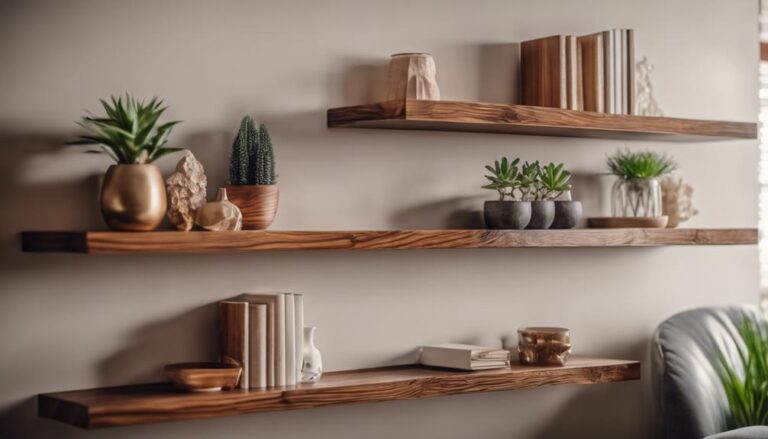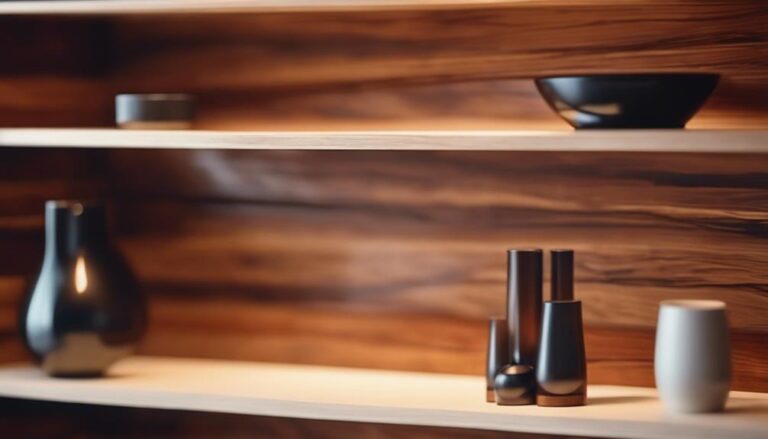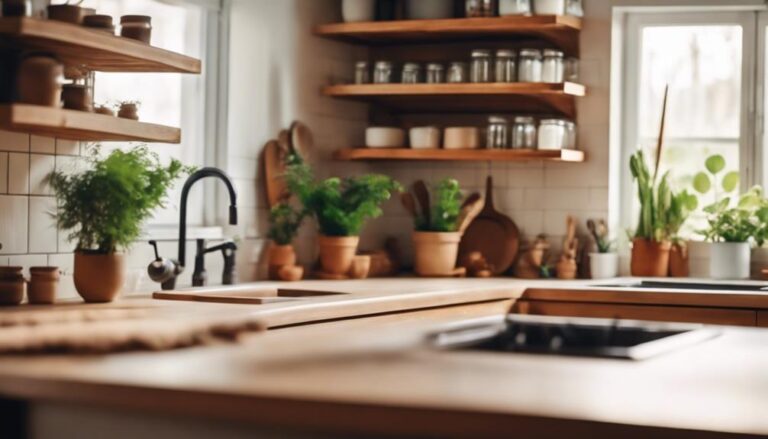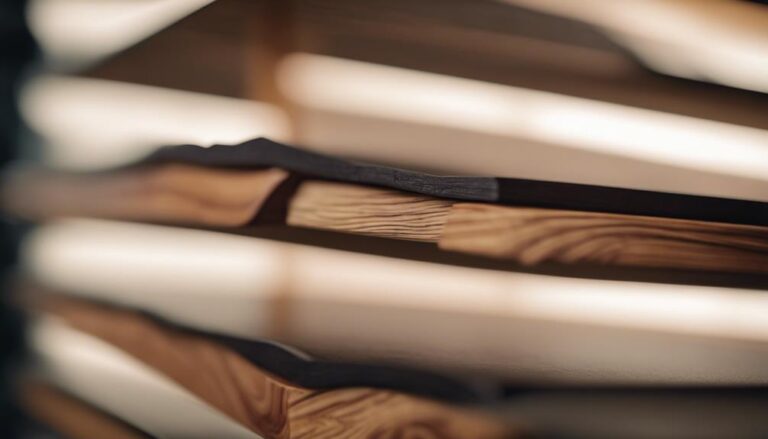The Impact of Stains and Dyes on Wood Finish for Floating Shelves

When selecting stains and dyes for wood finishes on floating shelves, we have the power to transform their appearance and enhance their durability significantly. Stains amplify the natural grain of the wood, adding depth and a cozy warmth, while dyes create a more consistent color that brings out intricate details. Proper preparation is crucial for achieving a flawless finish, including thorough cleaning, sanding, and conditioning of the wood.
Stains like Early American or Special Walnut can be carefully chosen to complement existing decor, creating visual harmony within the space. It is important to be cautious of common pitfalls such as over-application of stains and inadequate surface preparation, as these can affect the final result of the finish.
By selecting the appropriate products and employing the right techniques, we can craft stunning floating shelves that not only look beautiful but also last for a long time.
To delve deeper into the detailed steps and valuable tips for achieving the perfect wood finish on floating shelves, stay tuned for more information.
Key Takeaways
When it comes to finishing floating wood shelves, the choice between stains and dyes plays a crucial role in enhancing the overall aesthetic appeal of the shelves. Stains, with their warm tones and intensified color variations, accentuate the natural beauty of the wood, creating a cozy and inviting atmosphere in any space. On the other hand, dyes offer a more uniform color finish, showcasing intricate wood grain patterns with precision and elegance.
Applying the right stain or dye not only adds visual appeal but also serves as a protective layer for the wood, guarding it against wear and tear and ensuring its longevity. By carefully selecting the appropriate finish, you can enhance the durability of the floating shelves while maintaining their natural charm.
The decision between stains and dyes ultimately depends on your desired color intensity and design objectives. If you aim for a rich, vibrant color palette with distinct variations, stains might be the ideal choice. However, if you prefer a more consistent and uniform color scheme that highlights the intricate details of the wood grain, dyes could be the perfect option for your floating shelves.
Proper application of stains and dyes is essential to avoid common mistakes and preserve the wood's natural features and finish. By following best practices and techniques in staining or dyeing wood, you can achieve a flawless and long-lasting result that elevates the look of your floating shelves.
Understanding Wood Types
When choosing wood for floating shelves, it's crucial to understand the characteristics of different types like pine, alder, maple, white oak, and walnut, and how they interact with stains and dyes. Each wood variety has unique features that significantly impact the final appearance of the shelves.
Pine boasts striking grain lines that can create visually appealing contrasts when stained, while alder offers a smooth, creamy finish ranging from rustic to exquisite, making it adaptable to various design styles.
Maple stands out for its bright white color and contemporary vibe, making it an ideal option for a modern look. Its smooth surface ensures even absorption of stains, resulting in a clean and polished finish.
On the other hand, white oak is known for its natural, unstained appearance, offering a versatile and timeless aesthetic. The grain pattern of white oak beautifully complements both light and dark stains, enhancing its inherent elegance.
For those aiming for a sophisticated and elegant finish, walnut is a top choice. Renowned for its rich, classic brown color, walnut can be further highlighted with the right dye to bring out its luxurious undertones.
Benefits of Staining Wood
Staining wood enhances the natural beauty of the grain patterns and allows for customization of floating shelves. With a variety of colors available, ranging from light and airy to rich and dark, stains offer the opportunity to perfectly match the shelves with any design aesthetic. This customization results in a unique and polished look that not only elevates the space but also provides protection for the wood.
Staining wood is a common practice in woodworking and interior design. It not only enhances the visual appeal of the wood but also adds a layer of protection against wear and tear. By selecting the right stain color and finish, we can create a cohesive and stylish look for our floating shelves that complements the overall decor of the room. Additionally, staining helps to highlight the natural beauty of the wood, adding depth and character to the shelves.
The process of staining wood involves applying a pigmented liquid to the surface, which penetrates the wood and bonds with it chemically. This not only adds color but also seals and protects the wood from moisture and other environmental factors. By choosing the right stain for our floating shelves, we can ensure their longevity and durability while enhancing their aesthetic appeal.
Enhances Wood Grain
Staining wood highlights the natural patterns in the grain, adding depth and character to the surface. Wood stains reveal the intricate details of the wood grain, showcasing knots, swirls, and growth rings that might go unnoticed otherwise. This process enhances the wood grain, making each floating shelf a unique piece of art.
The choice of stain color significantly impacts how these natural features are emphasized. Lighter stains bring out the subtle contrasts within the wood fibers, while darker stains create a bold, dramatic effect. By penetrating the wood fibers, stains ensure the color is durable and resistant to wear and tear, preserving the shelf's beauty over time.
In home decor innovation, blending aesthetics with functionality is key. Staining wood achieves this by preserving the wood's integrity and enhancing its visual appeal. The application of wood stains transforms ordinary wooden surfaces into polished focal points in any room.
This method allows us to appreciate the natural beauty of the wood grain, turning floating shelves into timeless, elegant additions to our living spaces.
Customizes Shelf Appearance
Staining wood gives us the freedom to customize the appearance of our floating shelves to perfectly complement any style of decor. The various wood stain colors available allow us to enhance the natural beauty of the shelves, showcasing the distinct grain patterns that make each piece unique.
Whether we prefer a cozy, rustic feel or a sleek, contemporary look, the right wood stain can elevate the raw wood into a work of art.
Wood stains and dyes penetrate deep into the wood, ensuring a long-lasting color that resists fading and wear. This durability means our shelves will keep their vibrant look over time, even in high-traffic areas.
With a wide selection of wood colors to choose from, we can fully personalize the appearance of our shelving units to harmonize with our living spaces.
Beyond aesthetics, staining wood also provides protection. A high-quality wood stain acts as a shield, safeguarding our shelves from moisture, sunlight, and daily use, significantly extending their lifespan.
Choosing Between Stains and Dyes
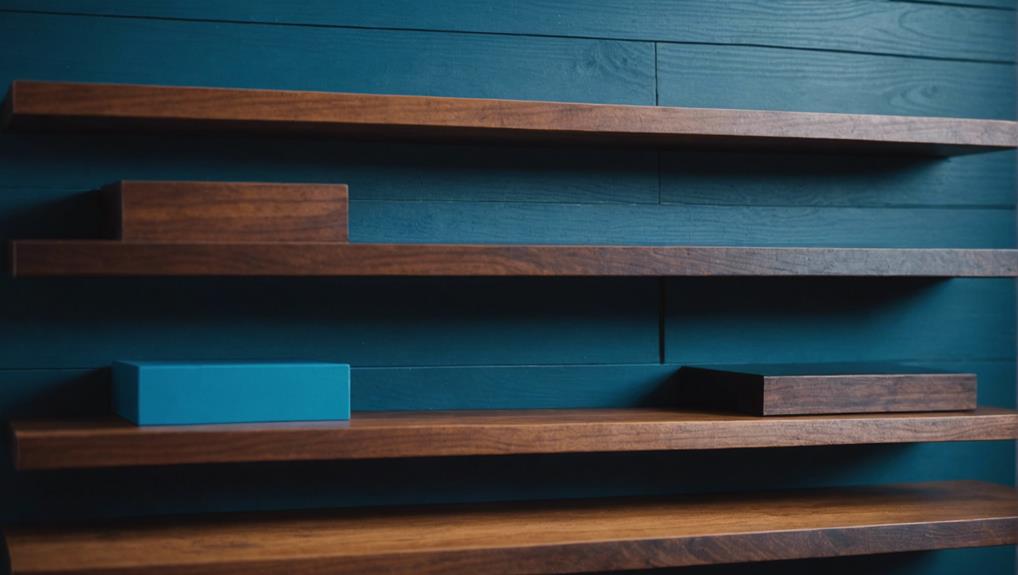
When deciding between stains and dyes for our floating shelves, it's important to consider the differences in color consistency and application techniques. Stains, with their pigmented finishes, emphasize the natural characteristics of wood, while dyes penetrate deeper, offering a more uniform color.
Each method has its own application process, with stains often requiring more drying time and dyes providing easier, quicker coverage.
Stains bring out the unique grain patterns and textures of wood, creating a rich and warm look. On the other hand, dyes provide a more consistent and even color throughout the wood, giving a modern and sleek appearance to the shelves.
Understanding these differences can help us choose the finish that best suits our design aesthetic and preferences.
Color Consistency Differences
Deciding between stains and dyes depends on the balance we want to strike between color consistency and the visibility of the wood grain when finishing floating shelves. It's crucial to consider how each option interacts with the wood fibers.
Stains deeply penetrate the wood, enhancing its natural color variations, while dyes sit on the surface, providing a more even color. This key distinction can significantly impact the final appearance of our shelves.
Stains offer the following characteristics:
- Intensified natural color variations
- Deeper penetration into wood fibers
- A wider array of color choices
- Different drying times based on whether they're oil-based or water-based formulations
On the flip side, dyes deliver a consistent color while still showcasing the wood grain prominently. Due to their transparency, dyes allow the intricate patterns of the wood grain to be prominently displayed, resulting in a visually pleasing and uniform finish. This makes dyes a great option for those who prioritize the natural beauty of wood while aiming for a consistent appearance.
In the end, our decision between stains and dyes will be guided by our design objectives. If we value the uniqueness and character of each piece of wood, stains may be the preferable choice. For a modern, sleek look with uniform color, dyes could be the ideal solution.
Application Techniques Compared
When applying stains and dyes to floating shelves, different techniques are used to achieve varying effects on the wood's final appearance. Stains are chosen to penetrate the wood surface, enriching the grain and creating depth in the finish. The application of stains typically involves either wiping or brushing the stain onto the wood, allowing for control over the intensity of the color. This method is effective for creating a wide array of colors and for layering to create custom shades. Stains are versatile, working well with different types of wood and finishes, making them a popular choice for many projects.
On the other hand, dyes directly color the wood fibers, resulting in a more vibrant and consistent look. To apply dyes effectively, precise mixing and careful application are necessary to ensure uniformity. This technique is ideal for those looking for intense, even coloring without compromising the wood's texture. Dyes are best suited for lighter woods and can be blended to achieve specific colors, offering a high level of customization for unique designs.
Ultimately, the decision between stains and dyes depends on the desired wood finish and the specific aesthetic goals for the floating shelves. Both options have their distinct advantages, and understanding the application techniques associated with each can help in achieving the desired look for the project.
Popular Stain Colors
When it comes to floating shelves, the choice of wood finish can significantly impact the overall look and feel of your space. Among the popular stain colors for floating shelves, Early American, Special Walnut, Pecan, and Willowbend are standout options. Each of these stains offers a unique hue and the ability to enhance the natural wood grain.
Early American stain presents a golden light brown shade that exudes traditional warmth and charm. It adds a touch of classic elegance to any room.
Special Walnut, on the other hand, boasts a versatile light brown tone with warm undertones, providing a blend of classic and modern appeal that's hard to resist.
Pecan stain offers a medium-brown color that beautifully highlights the wood's natural grain, creating a rich and earthy look that many homeowners love.
Lastly, Willowbend introduces a cooler dark brown with subtle gray undertones, perfect for achieving a contemporary and sophisticated aesthetic.
These stain colors can be creatively used to match or complement existing wood tones in your home, contributing to a cohesive design scheme. The choice of stain color plays a crucial role in setting the style and ambiance of your floating shelves, so it's essential to choose wisely.
Preparing Wood for Staining

To ensure our floating shelves look their best, we must start by thoroughly cleaning and sanding the wood, creating a smooth surface for optimal stain absorption.
It's essential to select the right wood conditioner to prevent any blotchiness and achieve a consistent finish.
These steps lay a strong foundation for a stunning and long-lasting wood finish on our floating shelves.
Cleaning and Sanding Techniques
Getting the right materials for your floating wood shelf is crucial for achieving a professional finish. Before staining, it's vital to thoroughly clean and sand the wood to ensure a flawless result. Start by wiping the wood with a damp cloth to remove any dirt, dust, and oils that might affect the stain's application. Once the wood is dry, move on to sanding techniques.
Sanding plays a key role in smoothing the wood surface for optimal stain absorption. Begin with a coarse grit, such as 120, and gradually progress to finer grits like 150 and 220. This step-by-step sanding process guarantees that the wood's surface is even and well-prepared for staining.
After sanding, it's important to eliminate any remaining dust particles. A tack cloth is ideal for this task as it effectively picks up fine dust, leaving the wood spotless.
To simplify the process, follow these steps:
- Initial Cleaning: Use a damp cloth to wipe away surface grime.
- Progressive Sanding: Start with 120 grit and move to 150 and 220 for a smooth finish.
- Final Dust Removal: Employ a tack cloth to capture any remaining particles.
- Inspection: Check the wood thoroughly for any missed spots or imperfections.
It's essential to invest time and effort in preparing the wood properly before staining to ensure a professional and long-lasting finish for your floating wood shelf.
Choosing Appropriate Wood Conditioner
Selecting the right wood conditioner is crucial for achieving a smooth and professional stain on your floating wood shelves. Preparing the wood surface with a conditioner helps ensure consistent stain absorption, which is essential to avoid uneven blotches. This step is especially important for softwoods like pine, known for their tendency to absorb stain unevenly.
Using a wood conditioner is a key element in our woodworking projects, helping to reduce blotching and achieve a uniform finish for a polished appearance. Softwoods, with their distinct grain patterns, greatly benefit from this preparatory treatment, allowing the stain to penetrate evenly.
To apply the wood conditioner effectively, it's important to carefully follow the manufacturer's instructions. This ensures that the wood is properly prepped, enhancing the overall look of the shelves. Typically, the process involves brushing or wiping the conditioner onto the wood, allowing it to sit for a specified time, and then wiping off any excess before applying the stain.
Applying Wood Stain Evenly
To achieve a uniform finish on floating wood shelves, it's essential to begin with a clean and dry surface. Proper preparation of the wood before applying any finish is crucial. Utilizing a soft, lint-free cloth is key to ensuring that no dust or impurities affect the final result.
Innovating the technique for finishing wood shelves involves these steps:
- Apply the selected wood finish with a clean cloth, following the natural grain of the wood.
- Allow the finish to penetrate the wood for a few minutes to ensure even color absorption.
- Wipe off any excess finish to prevent streaks or uneven patches on the surface.
- Ensure the finished wood shelf is completely dry before adding any protective topcoat.
Enhancing Grain With Dyes

Enhancing the inherent beauty of wood grain with dyes can truly elevate the appeal of floating shelves. Dyes penetrate deeply into the wood fibers, enriching the natural patterns and introducing vibrant hues that set the shelves apart. Unlike stains, dyes offer a more consistent application, granting greater precision over the color's intensity and depth.
Through the strategic layering of various dye colors, we can craft bespoke shades and distinctive visual effects that are unattainable with a single color application. This technique allows for the accentuation of specific grain patterns, resulting in a visually dynamic finish that accentuates the wood's innate allure.
Water-based dyes represent a cutting-edge option, delivering environmental advantages and simplified clean-up in comparison to their oil-based counterparts. Not only do these dyes lessen the ecological impact, but they also streamline the application process, making it more user-friendly for DIY enthusiasts and professionals alike.
Sealing and Protecting Wood
Once we've enriched the wood grain with vibrant dyes, the next crucial step is to seal and protect the wood to ensure the longevity and vividness of our floating shelves. Sealing the stained wood not only enhances its appearance but also establishes a strong barrier against moisture and wear. This essential process guarantees that the wood maintains its rich color and intricate grain patterns, preserving its aesthetic appeal over time.
Stains and dyes deeply penetrate the wood fibers, offering long-lasting color and protection. Let's explore the significant advantages of sealing and protecting wood for floating shelves:
- Enhanced Durability: Sealing acts as a shield, safeguarding the wood from scratches, spills, and daily wear and tear.
- Moisture Resistance: Proper sealing prevents water damage, crucial for floating shelves exposed to fluctuating humidity levels.
- Color Preservation: The vibrancy of dyes and the depth of stains remain intact, preventing any fading or discoloration.
- Grain Highlighting: Sealing accentuates the natural beauty of the wood grain, ensuring each shelf is a unique masterpiece.
To achieve exceptional and long-lasting results, it's imperative to choose the right sealant that complements the selected stains and dyes. This final touch not only protects the wood but also amplifies the visual impact, making our floating shelves a standout feature in any space.
Matching Stains to Decor
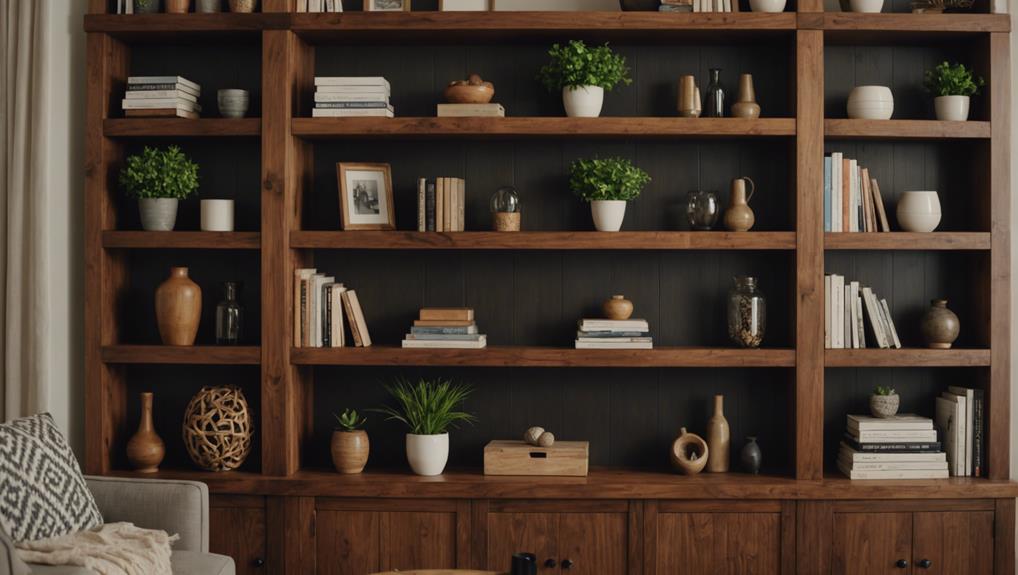
Choosing the right stain for our floating shelves is crucial to ensuring they complement and enhance the existing decor in our space. By carefully matching stains to our decor, we can create a cohesive look that seamlessly fits with the room's aesthetic. It's essential to consider the wood tones already present in our furniture and accent pieces. Opting for wood stains that either match or enhance these tones will add depth and visual interest without overpowering the design.
In our pursuit of creativity, we should consider exploring complementary stain colors. These hues can highlight the natural beauty of our floating shelves while adding a touch of elegance to the room. By harmonizing different wood tones through matching stains, we can achieve a balanced blend that enhances the overall visual appeal of the space.
While an exact match isn't always necessary or recommended, subtle variations can introduce a dynamic element, making the room feel more inviting and distinctive.
Ultimately, selecting stain colors that harmonize well with our decor is key to achieving a cohesive look. By paying attention to the nuances in wood tones and opting for complementary shades, we can elevate the aesthetic of our floating shelves and ensure they stand out as a stylish focal point in the room.
Common Mistakes to Avoid
When selecting stains for our floating shelves, it's crucial to consider how they'll complement our decor. However, we must also steer clear of common mistakes that can spoil the final look. Errors in the staining or dyeing process can mar the natural beauty of the wood and the overall room aesthetic.
One significant blunder to avoid is applying an excessive amount of stain or dye, as this can lead to a patchy or uneven color finish on the wood. It's best to apply these finishes in moderation and gradually build up the desired hue. Properly preparing the wood surface is equally essential. Failure to sand the wood adequately can result in a rough surface that won't absorb the stain or dye evenly.
It's important to exercise caution when using darker stains or dyes, as they may obscure the intricate grain and details of the natural wood. Conducting a test on a small, inconspicuous area allows us to preview the final color and make any necessary adjustments before treating the entire piece.
Here are some key takeaways to keep in mind:
- Avoid over-applying stain or dye.
- Ensure proper sanding and preparation of the wood surface.
- Be mindful of the impact of darker stains or dyes on the wood's natural features.
- Always conduct a test on a small area before proceeding with the entire piece.
Tools for Staining Wood
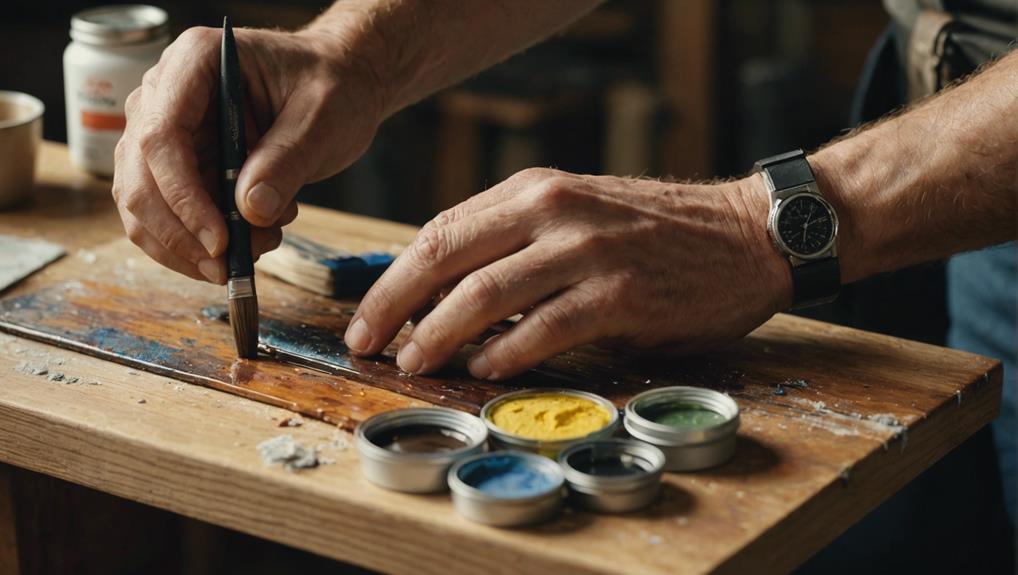
To achieve a professional finish on our floating shelves, it's crucial to use the right tools for staining wood. Stain pads are highly effective for achieving a flawless and consistent look, providing excellent application control. When paired with staining sponges, they offer versatility, especially for intricate details and edges, ensuring a seamless finish.
Before applying the stain, proper wood surface preparation is essential. Sandpaper is key for smoothing out imperfections and opening up the wood grain for optimal stain absorption. Additionally, using wood conditioners is a game-changer as they prevent blotching by promoting uniform absorption, resulting in a more polished appearance for our shelves.
Ensuring safety is paramount, so don't forget to wear protective gear like gloves, goggles, and a respirator. These essential tools safeguard your skin, eyes, and lungs from harmful chemicals and fumes, allowing you to focus on achieving a flawless finish.
Equipped with these tools and techniques, you'll transform your floating shelves into stunning focal points that showcase your craftsmanship and attention to detail.
Maintenance of Stained Shelves
After achieving a flawless finish on our floating shelves, it's essential to maintain them properly to preserve their beauty and durability. Stained shelves, when cared for correctly, can remain vibrant and long-lasting for years.
Here are some key steps to ensure our shelves stay in excellent condition:
- Regular Dusting: Use a soft cloth or microfiber duster to remove dust and debris regularly. This helps prevent any build-up that could potentially scratch the surface of the shelves.
- Avoid Harsh Chemicals: Stay away from abrasive cleaners that may harm the wood finish. It's best to use gentle, wood-specific products for cleaning.
- Wood Polish Application: Applying a wood polish or conditioner periodically helps keep the stained wood hydrated and maintains its vibrant appearance over time.
- Sunlight Protection: Direct sunlight can cause fading and discoloration of the shelves. It's advisable to place them in areas with limited sun exposure or use curtains to filter the light effectively.
For minor scratches or imperfections, touch-up stain pens or markers can be used to repair and maintain a seamless finish.
Frequently Asked Questions
What Are the Disadvantages of Stain Finishes on Wood?
Color inconsistency and uneven absorption are common issues when it comes to applying stain finishes on floating wood shelves. This can result in a blotchy appearance that detracts from the overall aesthetic of the shelves. Additionally, stains do not provide sufficient protection, making the shelves more susceptible to damage and requiring frequent maintenance to keep them looking their best.
The limited protection offered by stain finishes can be a significant disadvantage, especially in high-traffic areas or environments where the shelves are exposed to moisture or other elements. Without proper protection, the wood may be more prone to damage, such as warping or discoloration, which can impact the longevity of the shelves.
Innovative and flawless finishes may be harder to achieve with stain finishes due to their tendency to result in color inconsistencies and blotchy outcomes. This can limit the design possibilities and overall appeal of the floating wood shelves, making it challenging to create a cohesive and visually appealing look.
Exploring alternative wood finishing options, such as sealants or lacquers, may help overcome the drawbacks associated with stain finishes and ensure that floating wood shelves maintain their beauty and durability over time. By choosing the right finish for your shelves, you can enhance their appearance and longevity while minimizing maintenance challenges.
Can You Stain Floating Shelves?
Yes, floating shelves can be stained to enhance their appearance. By using a variety of stain types and application techniques, we can achieve different color variations to match the style of our space. It is important to consider the drying time of the stain to ensure a flawless finish on the shelves. By embracing innovation and adding character to our spaces through staining, we can create a unique and personalized look for our floating shelves.
How Does Stain Affect Wood?
Staining oak tables can enhance the beauty of the wood by bringing out the natural grain patterns. The color depth is intensified by the stain, and the absorption rate of the wood varies, resulting in a unique final appearance. The surface texture of the wood becomes more pronounced, creating a visually pleasing aesthetic.
Different wood finishes can also be applied to floating wood shelves to achieve various looks and textures. Options such as matte, glossy, or satin finishes can provide different levels of shine and smoothness to the shelves. Each finish option can impact the overall appearance and feel of the shelves, allowing for customization based on personal preferences and interior design styles.
In addition to staining, other wood finish options for floating wood shelves include painting, varnishing, or leaving the wood untreated for a more natural look. Each of these finishes can offer different levels of protection, durability, and aesthetics to the shelves. Choosing the right wood finish is essential to ensure the longevity and visual appeal of the floating wood shelves in your space.
Do I Need to Seal Stained Wood Shelves?
Yes, sealing stained wood shelves is essential for maintaining their quality and longevity. By sealing the wood, we provide protection against moisture, which can lead to warping or damage over time. This protective layer also helps the stain on the shelves last longer, preserving the aesthetic appeal of our innovative designs. Additionally, sealing the wood enhances the durability of the finish, making it easier to clean and maintain the shelves in the long run.
When it comes to floating wood shelf materials, the wood finish plays a crucial role in both aesthetics and functionality. By choosing to seal our stained wood shelves, we ensure that our designs remain pristine and stand the test of time. The protective sealant not only enhances the overall look of the shelves but also makes them easier to clean and maintain, adding to their appeal and functionality.
Conclusion
We've delved into the intricate world of stains and dyes, uncovering their transformative effects on wood for our exquisite floating shelves. Understanding the characteristics of different wood types, selecting the perfect stain or dye, and diligently preparing the wood are crucial steps in achieving a finish that elevates our living space.
Steer clear of common mistakes, utilize the appropriate tools, and maintain your shelves regularly to ensure they maintain their pristine appearance. Armed with these insights, your floating shelves won't only serve a functional purpose but also become captivating focal points in your decor.

